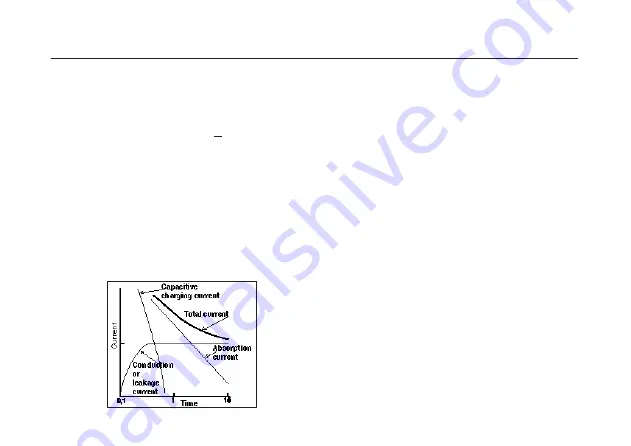
12
Insulation Testing Concepts
Insulation resistance can be considered by
applying Ohm’s Law. The measured
resistance is determined from the applied
voltage divided by the resultant current,
V
R =
I
There are two further important factors to be
considered. These are:
(i)
the nature of the current through
and/or over the insulation, and:
(ii)
the length of time for which the test
voltage is applied. These two factors
are linked.
The total current that flows is made up of three
separate currents:-
1) Capacitance charging current. This current
is initially high and drops as the insulation
becomes charged up to the applied
voltage.
2) Absorption current. This current is also
initially high but drops at a much slower
rate than the charging current.
3)
Conduction or Leakage current.This is a
small steady current that can be sub-
divided into two:-
(a) A current flowing along conduction paths
through the insulation material.
(b)
A current flowing along conduction
paths over the surface of the insulation
material.
As the total current depends upon the time for
which the voltage is applied, Ohm’s Law
theoretically applies at infinite time.
The charging current falls relatively rapidly as
the equipment under test becomes charged
up. The actual length of time depends upon
the size and capacitance of the item under
test.
Larger items with more capacitance will take
Summary of Contents for BM80/2 Series
Page 19: ...Typical Terminal Voltage Characteristics 18 BM80 2 BM82 2 only...
Page 22: ...21...
Page 42: ...Caract ristiques types de tension de borne 41 BM80 2 BM82 2 seulement...
Page 45: ...44 M BM80 2 Serie Mehrfachspannungs Isolations und Durchgangspr fer Gebrauchsanleitung...
Page 64: ...Charakteristika einer typischen Anschlu spannung 63 nur bei BM80 2 und BM82 2...
Page 67: ...66 M Serie BM80 2 Probador de aislamiento y continuidad de voltaje multiple Gu a del Usuario...
Page 86: ...Caracter sticas de voltaje de bornes t pico 85 S loBM80 2 y BM82 2...














































